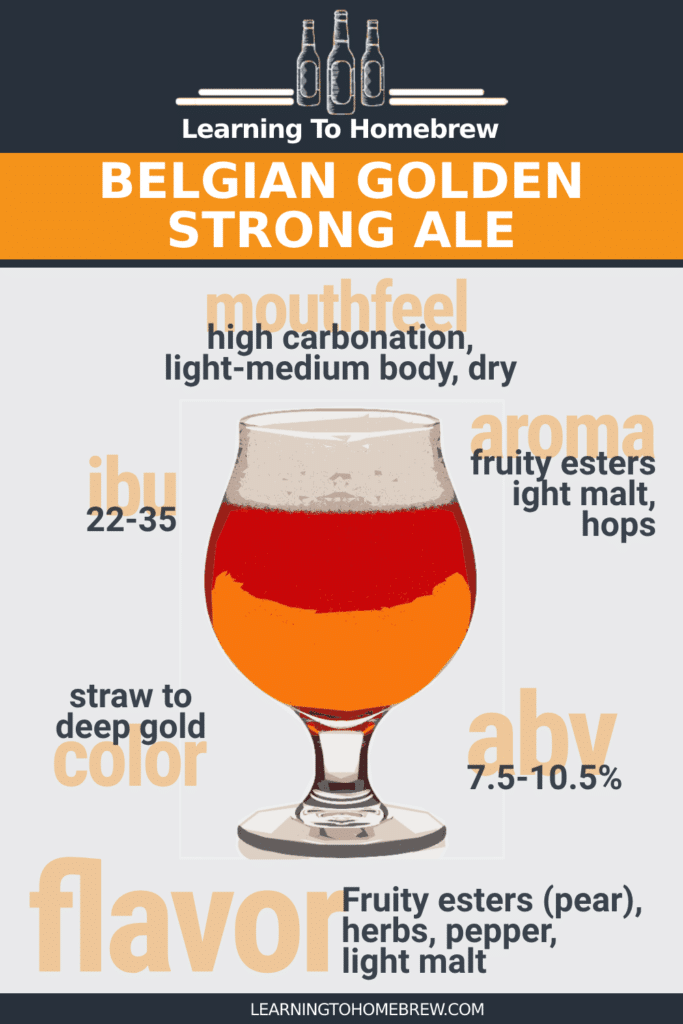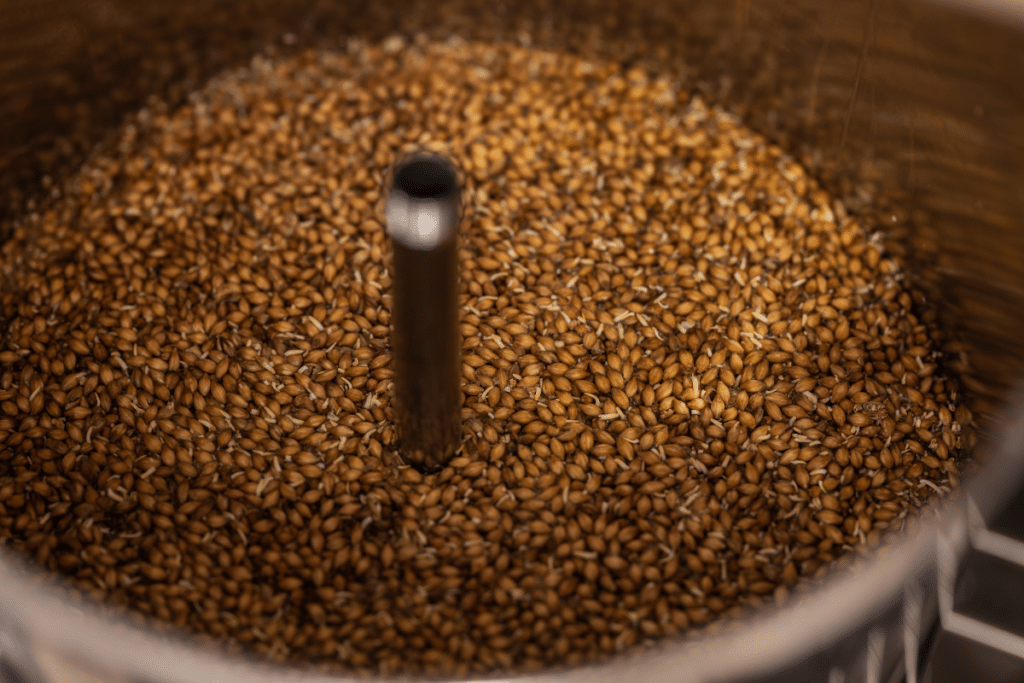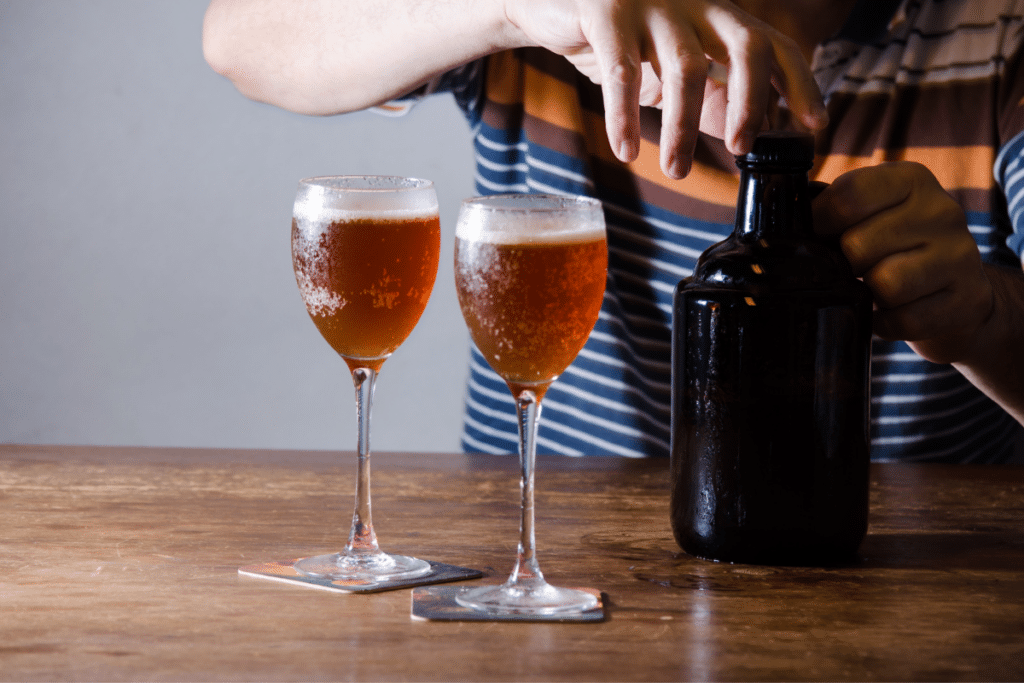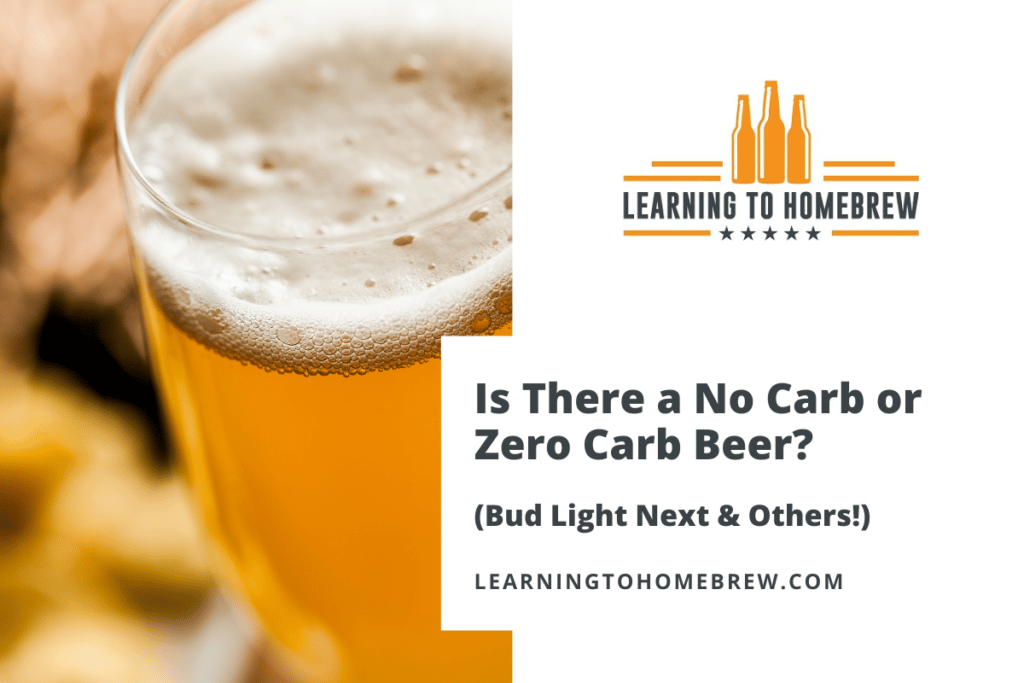Belgian beers are often considered some of the best beers. This is only achieved by quality ingredients, the best brewing practices, and great recipes. Homebrewers can brew a great Belgian golden strong ale with knowledge of the style.
Brew a flavorful Belgian golden strong ale with fairly soft water balanced between chlorides and sulfates. Use a grain bill made up of Pilsner malt with a small portion of Candi sugar. Choose German noble hops or similar characteristics. Pick a yeast that has high attenuation, medium flocculation, medium ester production, and high ABV tolerance.
Let’s go over ingredients, processes, and recipes in detail to achieve the best Belgian beer possible.
Topics We Cover
What is a Belgian golden strong ale?
A Belgian golden strong ale is a deceptively strong ale that resembles a lighter lager.
This style showcases fruity flavors and high carbonation. Upon the first sip, you will taste subdued malt flavors, herbal hops, and soft alcohol with a dry finish. The aroma of a Belgian golden strong ale present more of the same. Like the flavors, the malts do not dominate the aromas. Instead, the main aromas are hop characteristics and fruity esters.
When it comes to the mouthfeel, this style is relatively light considering its ABV. It is highly carbonated with an overall dry feel and finish. As it is 7.5% ABV or higher, you will detect the alcohol. That said, good examples will not have an overly hot or solvent-like alcohol character.

Defining characteristics of Belgian golden strong ales include:
- Color – 3-6 SRM (straw to deep gold)
- Common flavor – Fruity esters (pear), herbs, pepper, light malt
- Aroma – Hops, fruity esters, light malt
- Mouthfeel – High carbonation, light-medium body, dry
- IBUs (Bitterness) – 22-35
- ABV – 7.5-10.5%
History of the Belgian golden strong ale beer
The origins of the Belgian golden strong ale can be traced to Breendonk, Belgium. The Duvel Moortgat Brewery, then led by Albert Moortgat, brewed a darker version of the style using Scottish yeast just after WWI. The beer was named Victory Ale.
The Victory Ale was soon after renamed “Duvel” or Devil, supposedly in reference to a tasting event during which one of the tasters exclaimed that the beer was the real devil. Today, Duvel is synonymous with the Belgian golden strong ale style.
This early Duvel evolved over the next several decades. By 1970 it had finally become the pale beer we know today.
Popular commercial Belgian golden strong ales
For the beer enthusiasts and the beer curious here’s a quick list of Belgian golden strong ales you should try.
- Brouwerij Duvel Moortgat Duvel – The original Belgian golden strong ale. This beer features quality hops with light malt and bitterness.
- Brouwerij Huyghe Delirium Tremens – Another great example of the style. Delirium Tremens is warming yet well-rounded.
- Goose Island Beer Co. Matilda – This delicious beer provides dry fruit flavors and spices with a dry finish.
- Russian River Brewing Company Damnation – A great beer to try if you like the fruity character of a Belgian golden strong ale.
Popular Belgian Strong Blonde Ale recipe kits (all-grain or extract)
Trés Fem is a delicious, crisp and very drinkable ale that combines a slight bit of tartness with a delicate cherry flavor, strongly reminiscent of a Belgian Kriek.
2-Row Pale, Flaked Barley and Wheat Malt build the beer up, while Saaz hops balance it out. Tart cherries are what turn this semi-standard recipe into such a craveable beer.
How to brew a Belgian golden strong ale
Once you’ve explored some great examples of Belgian golden strong ales, you may be thinking of how to brew your own. In order to brew the best beer, you need to know the style forward and backward. To that end, I will break down everything you need to know.
To brew a flavorful Belgian golden strong ale with fairly soft water balanced between chlorides and sulfates. Your grain bill should be made up of Pilsner malt with a small portion of Candi sugar. Choose German noble hops or other hops with similar characteristics. The yeast should have high attenuation, medium flocculation, medium ester production, and high ABV tolerance.
Let’s start by going over some great choices for the recipe and ingredients. Then, we can look at the process including brew day, fermentation, and bottling.
Recipe and ingredients
While you can’t have beer without fermentation, you can’t get anywhere without quality ingredients. There are of course no wrong ingredients, but some will go together much better than others.
The recipes for this style typically use the same ingredients with some variation here and there:
- Water profile
- Base grains
- Specialty grains or other additions
- Hops
- Yeast
As always, start with your water. Then consider your grain bill, hops, and finally yeast. Each one can have a significant impact on your final product.
Water profile
Since beer is nearly 90% water, good water makes good beer.
The best water profile for a Belgian golden strong ale is soft with either a balanced chloride-to-sulfate ratio or a lean toward sulfates.
Since you won’t be using dark malts you won’t need to include any residual alkalinity. You may need to lower the pH to hit the 5.2-5.6 range. Use a mash pH calculator to determine what your adjustments will be with your grain bill.
The chloride and sulfate balance will be determined by your goals. A balance between the two is a safe choice, however, as there is not a strong preference for malts or bitterness in the style.
That said if you want to lean one way or another, lean towards sulfates as bitterness is typically more prominent.
Base grains
The base grains for a Belgian golden strong ale can be primarily Pilsner malt. Some brewers add a small amount of wheat or any pale 2-row.

All you really need is Belgian Pilsner Malt since this beer style does not focus on the malt flavors. Any other base malts are personal choices but are generally just unnecessary complications.
Specialty grains or other additions
Specialty grains are not common in a Belgian golden strong ale. However, the use of sugar is.
Cane, Candi, and corn sugar are often used to raise the original gravity. Any Candi sugar you use should be the clear variety.
If you do choose to add some specialty grains, do so sparingly. Some of the acceptable inclusions are biscuit, aromatic, or acidulated malts. That last choice is only included to lower the mash pH.
Hops
Hops are very important to a Belgian golden strong ale.
This style needs bitterness, flavor, and aroma from hops. German noble hops are always a good choice. Generally look for hops that contribute a floral, spicy character.
If you cannot get a hold of any German noble hops, the various substitutes will work as well.
Bittering
Bittering hops added early in the boil will go through a process called isomerization. This is what gives a beer its bitterness.
A Belgian golden strong ale calls for anywhere from 22 to 35 IBUs.
Here are some good choices for bittering hops.
| Name | Purpose | Alpha Acid % |
|---|---|---|
| Saaz | Flavor + Aroma | 2.5-4.5 |
| Hallertau | Flavor + Aroma | 3.5-3.5 |
| Tettnang | Flavor + Aroma | 2.5-5.5 |
| Magnum | Bittering | 12-14 |
Aroma and flavor
Aroma and flavor hops added towards the end of the boil don’t add much bitterness. Instead, they add oils that provide flavor and aroma.
Belgian Golden strong ale beers can make use of a mid-boil addition to add bitterness and flavor.
Here are a few good choices to get you started.
| Name | Flavor/Aroma | Alpha Acid % |
|---|---|---|
| Tettnang | Woody, floral, citrus, cream | 2.5-5.5 |
| Saaz | Woody, floral, citrus, cream | 2.5-4.5 |
| Hallertau | Herbal, woody, floral | 3.5-3.5 |
| Liberty | Floral, spicy | 3-6 |
Yeast
The best yeast to use in a Belgian Golden strong ale is one that has high attenuation, medium to high flocculation, high alcohol tolerance, and medium ester production.
Most Belgian yeasts are a good choice though you can use any with the above characteristics. When it comes to the flavors, look for yeast strains that produce more fruity esters.
Dry
Below are some good dry yeast options for a Belgian golden strong ale.
| Name | Attenuation | Flocculation | Temperature Range | Alcohol Tolerance (ABV) |
|---|---|---|---|---|
| SafAle BE-256 | 82-86% | High | 64.4-78.8°F | 9-11% |
| Mangrove Jack M41 | 82-92% | Medium | 64-82°F | High |
| SafAle T-58 | 72-78% | Medium | 64.4-78.8°F | 9-11% |
Liquid
Below are some good liquid yeast options for a Belgian golden strong ale.
| Name | Attenuation | Flocculation | Temperature Range | Alcohol Tolerance (ABV) |
|---|---|---|---|---|
| Wyeast 1388 | 74-78% | Low | 64-80°F | 12-13% |
| WLP570 | 78-85% | Low | 68-75°F | 15+% |
| Wyeast 3522 | 72-76% | High | 65-76°F | 12% |
Brewing process
After acquiring all of your ingredients, you can move on to brew day. What you do on brew day can have just as much impact on your results as your choices of ingredients. On brew day, one of the most important aspects is sanitization. Be thorough when sanitizing.
All grain, partial, and extract brewing each have important considerations for you to make. When doing all-grain or partial brewing you need to consider mashing and sparging. From there the other considerations are similar. The boil step and on is the same for all three.
Let’s break down each step with the Belgian golden strong ale in mind.
Mashing
For a Belgian golden strong ale, you can either do a single infusion mash or a step mash.
A single infusion will work just fine but you can get more control with a step mash. If you do a step mash be sure to include a protein rest to promote clarity.
When doing a single infusion mash or the starch conversion rest, do so on the lower end of the standard range. By mashing on the lower end you will ensure that all of the sugars are easily fermentable, leading to a dryer beer.
Another important aspect of the mash is the pH. You want the mash pH to be between 5.2 and 5.6. Since the malts used in a Belgian golden strong ale won’t lower the pH enough, you may need to adjust it manually. There are a few ways to do so from acidulated malts, calcium sulfate, or calcium chloride.
Boil
After the mash and lauter, prepare for the boil.
A Belgian golden strong ale boil should be a simple hour-long boil. You can do an hour and a half though it is not always necessary. You will have hop additions towards the beginning and end so that you get both bitterness and flavor.
You won’t have a bunch of hop additions but there will be a few throughout the boil. You may also choose to use a fining agent to clarify the beer.
A longer boil will help stave off DMS and prevent the resulting off-flavors. That said, you will be alright with an hour-long boil.
Whirlpool or flameout
After the boil for your Belgian golden strong ale, you can whirlpool. This step is not essential to the style though it can help collect any trub. Some recipes use this time to add some hops for flavor.
While adding hops to the whirlpool can add flavor and aroma it won’t be necessary for this style. Any flavor you’ll need can be added during the boil.
Fermentation
When fermenting a Belgian golden strong ale, you’ll want to start at a low temperature and then raise it every day until fermentation finishes. Aside from fine temperature control, fermentation is standard.
If you cannot manage the temperatures to the degree, your beer should still turn out good. Simply try to keep it at a middling temperature during the process.
When fermentation is done you should lager this beer for at least two weeks. This will improve the clarity and crispness of the beer.
Temperatures
Generally, start a Belgian golden strong ale around 62°F to 64°F, assuming that is within your yeasts preferred range. If not, start at the lowest temp for your yeast. Then increase by a degree per day.
By starting low and going high you will encourage the yeast to consume every bit of sugar and produce esters. This further helps dry out the beer as well as provide the characteristic flavors.
Bottling or kegging
The debate between bottling and kegging is strong for some styles but not Belgian golden strong ale.
Bottling or kegging both work well for a Belgian golden strong ale. Traditionally, this style is bottle conditioned. However, do what you find easiest.

If you find one method easier for lagering then go with that method.
Belgian golden strong ale recipes
If you aren’t one to create your own recipes here are a few that you can follow for great results. These recipes are from various brewers as credited below.
- Belgian Strong Pale – La Chouffe (All Grain)
- Tread Carefully (All Grain)
- Bees Knees (Extract)
Belgian Strong Pale – La Chouffe (All Grain)
This recipe comes from user Bgaspard1777 on Brewer’s Friend.
Ingredients
- Belgian Pilsner Malt – 11.5 lb
- Clear Belgian Candi Sugar – 1 lb
- Belgian Caramel Pils – 0.5 lb
- German Acidulated Malt – 4 oz
- Styrian Goldings Hops – 1 oz
- Saaz Hops – 1 oz
- Coriander – 0.5 oz
- Whirlfloc
- Yeast nutrient – 1 tsp
- Wyeast 2522
Method
- Heat 4.5 gallons to 145°F.
- Add grain bill and mash for 30 minutes.
- Remove a portion, boil, then add to mash. Target temperature = 156°F.
- Rest for an hour.
- Remove a portion, boil, then add to mash. Target temperature = 168°F.
- Rest for 15 minutes.
- Mashout.
- Collect 6.86 gallons of wort.
- Boil for 90 minutes.
- Add the Styrian Goldings at 60 minutes left.
- Add half of the Saaz at 30 minutes left.
- Add the coriander, whirlfloc, and yeast nutrient at 15 minutes left.
- Add the rest of the Saaz at 5 minutes left.
- Flameout and transfer to the fermentor.
- Cool and pitch yeast.
- Start at 68° F during primary fermentation. Raise by 2° F per day until it reaches 82°F.
- After 1 week in primary transfer to secondary.
- Maintain near-freezing temperatures for 2 weeks to a month.
- Rack to keg or bottles. Age as desired. Enjoy!
Tread Carefully (All Grain)
This recipe comes from user dpatrickv on Brewer’s Friend.
Ingredients
- Belgian Pale Ale Malt – 14 lb
- German CaraRed – 3 lb
- Clear Belgian Candi Sugar – 1 lb
- Saaz hops – 2 oz
- Chardonnay-soaked oak chips – 3 oz
- Wyeast 1388
Method
- Heat 6.75 gallons to 152°F
- Add grain bill and mash for 1.5 hours.
- Mashout.
- Collect 7 gallons of wort.
- Boil for 90 minutes. Add the Saaz right away.
- Flameout and transfer to the fermentor.
- Cool and pitch yeast.
- Maintain 68° F during fermentation.
- Transfer to secondary. Lager for at least 2 weeks.
- Rack to keg or bottles. Age as desired. Enjoy!
Bees Knees (Extract)
This recipe comes from user Silver Brock on Brewer’s Friend.
Ingredients
- LME Pilsen – 9.5 lb
- Honey – 2 lb
- Munich malt – 2 lb
- Styrian Goldings – 3 oz
- Motueka hops – 3 oz
- Wyeast 1762
Method
- Heat 2.5 gallons of water for your boil.
- Add the steeping grains when the water is around 140°F.
- Remove the grains when the water is around 170°F.
- When a boil is reached, add the malt extract and the honey.
- Boil for 60 minutes. Add the Styrian Goldings right away.
- At 15 minutes left, add 2 oz of the Motueka.
- At 5 minutes left, add the rest of the Motueka.
- Flameout and transfer to the fermentor.
- Cool and pitch yeast.
- Maintain 70°F during fermentation.
- After 2 weeks rack to secondary and lager for 2-4 weeks.
- After lagering, rack to keg and force carbonate or bottle condition.
- Age as desired.
Did you know that we have a full library of homebrew beer recipes for every style?






